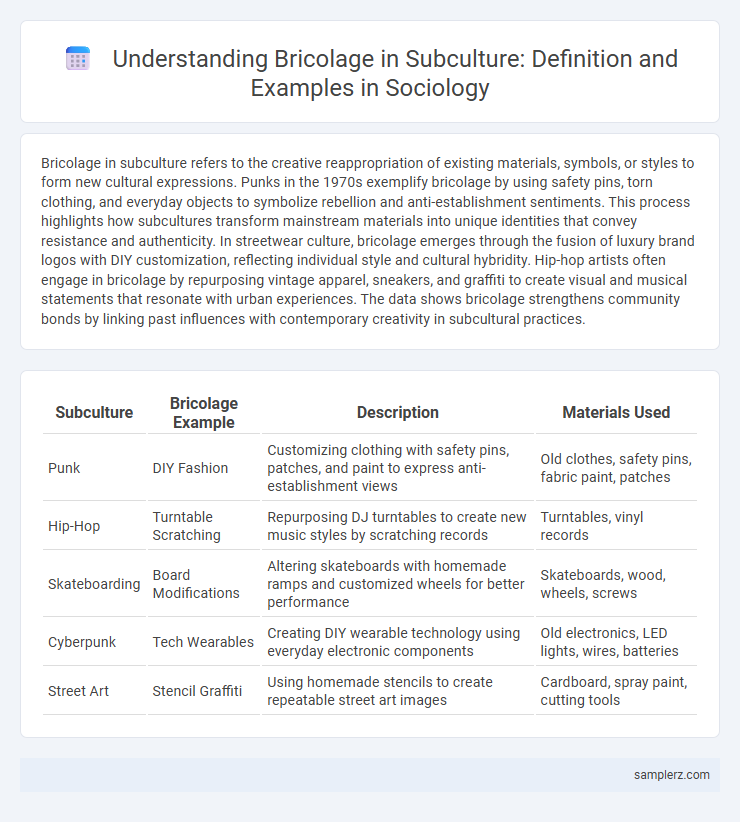Bricolage in subculture refers to the creative reappropriation of existing materials, symbols, or styles to form new cultural expressions. Punks in the 1970s exemplify bricolage by using safety pins, torn clothing, and everyday objects to symbolize rebellion and anti-establishment sentiments. This process highlights how subcultures transform mainstream materials into unique identities that convey resistance and authenticity. In streetwear culture, bricolage emerges through the fusion of luxury brand logos with DIY customization, reflecting individual style and cultural hybridity. Hip-hop artists often engage in bricolage by repurposing vintage apparel, sneakers, and graffiti to create visual and musical statements that resonate with urban experiences. The data shows bricolage strengthens community bonds by linking past influences with contemporary creativity in subcultural practices.
Table of Comparison
| Subculture | Bricolage Example | Description | Materials Used |
|---|---|---|---|
| Punk | DIY Fashion | Customizing clothing with safety pins, patches, and paint to express anti-establishment views | Old clothes, safety pins, fabric paint, patches |
| Hip-Hop | Turntable Scratching | Repurposing DJ turntables to create new music styles by scratching records | Turntables, vinyl records |
| Skateboarding | Board Modifications | Altering skateboards with homemade ramps and customized wheels for better performance | Skateboards, wood, wheels, screws |
| Cyberpunk | Tech Wearables | Creating DIY wearable technology using everyday electronic components | Old electronics, LED lights, wires, batteries |
| Street Art | Stencil Graffiti | Using homemade stencils to create repeatable street art images | Cardboard, spray paint, cutting tools |
Defining Bricolage in Social Subcultures
Bricolage in social subcultures involves creatively repurposing existing cultural materials, symbols, and artifacts to forge new meanings and identities within the group. This process reflects how members adapt mainstream cultural elements, such as fashion, music, and language, to express resistance or uniqueness. The practice highlights the dynamic, resourceful interaction between subcultures and dominant culture, emphasizing innovation through symbolic reinterpretation.
How Subcultures Use Bricolage for Identity
Subcultures use bricolage by creatively repurposing everyday objects and symbols to construct unique identities that challenge mainstream norms. This process involves mixing and matching cultural artifacts, fashion, and language to express distinct values and group belonging. By reinterpreting materials in unconventional ways, subcultures communicate resistance and authenticity within their social contexts.
Iconic Fashion Bricolage in Youth Movements
Iconic fashion bricolage in youth movements is exemplified by punk subculture, which redefined clothing by combining discarded materials like safety pins, leather jackets, and ripped fabrics to create bold, anti-establishment statements. This DIY aesthetic challenges mainstream fashion norms and fosters a unique identity through the creative reassembly of everyday objects. The bricolage technique in punk fashion symbolizes resistance and cultural rebellion, making it a lasting influence on contemporary youth style.
Music and Sound: Bricolage in Subcultural Expression
Bricolage in subcultural music and sound often manifests through the creative reassembly of diverse audio elements and instruments, leading to innovative genres like punk's use of distorted guitars and DIY recording techniques. This practice challenges mainstream music production by incorporating found sounds, unconventional instruments, and repurposed technology, reflecting cultural resistance and identity formation. The sonic bricolage within subcultures such as hip-hop and industrial music exemplifies how marginalized communities construct unique auditory experiences that resonate with their social realities.
DIY Aesthetics: Bricolage in Punk Culture
Punk culture exemplifies bricolage through its DIY aesthetics, where fans repurpose everyday materials like safety pins, torn fabrics, and band logos to create distinctive fashion statements and music expressions. This subcultural bricolage not only challenges mainstream consumerism but also fosters a sense of community and identity among punks by emphasizing creativity, resourcefulness, and anti-establishment values. The use of recycled and customized elements in punk attire symbolizes resistance and self-expression, making bricolage a central practice in its cultural and social dynamics.
Graffiti and Street Art as Urban Bricolage
Graffiti and street art exemplify urban bricolage by repurposing public spaces and materials to create vibrant, site-specific expressions of subcultural identity. Artists integrate found objects, walls, and urban textures to craft layered visual narratives that challenge mainstream aesthetics and authority. This bricolage process transforms overlooked urban elements into powerful symbols of resistance and community engagement.
Digital Remixing: Online Bricolage in Subcultures
Digital remixing exemplifies online bricolage in subcultures by creatively repurposing existing digital content such as music, videos, and memes to produce new, culturally significant expressions. Platforms like TikTok and Reddit serve as hubs where users merge diverse digital elements, facilitating hybrid identities and shared meanings within niche communities. This iterative process of digital bricolage fosters continuous innovation and the evolution of subcultural norms and aesthetics.
Protest and Resistance: Political Bricolage Tactics
Political bricolage tactics in protest and resistance movements often involve repurposing everyday objects and cultural symbols to challenge dominant power structures. Activists transform commonplace items such as clothing, graffiti, and digital media into tools of dissent, creating visually compelling and disruptive messages that resonate within their communities. These improvised strategies enable marginalized groups to articulate identity and opposition without reliance on formal resources, amplifying their political voice through creative adaptability.
Case Study: Bricolage in Skateboarding Communities
Skateboarding communities exemplify bricolage through their unique adaptation of urban environments, transforming everyday objects like rails, stairs, and benches into obstacles for tricks and creative expression. This subcultural practice redefines ordinary spaces, blending DIY ethos with cultural identity and resistance to mainstream commercialization. The ongoing innovation in skateboard design, apparel, and media also reflects a bricolage of influences that shape skateboarding's distinct aesthetic and social meanings.
Evolution of Bricolage Practices in Modern Subcultures
Modern subcultures continuously evolve their bricolage practices by repurposing everyday objects into symbolic artifacts that express identity and resistance. This adaptive reuse often incorporates digital media, street art, and fashion, blending traditional craft with contemporary technology to create unique subcultural aesthetics. The dynamic nature of bricolage fosters innovation and sustains cultural narratives within marginalized communities.

example of bricolage in subculture Infographic
 samplerz.com
samplerz.com